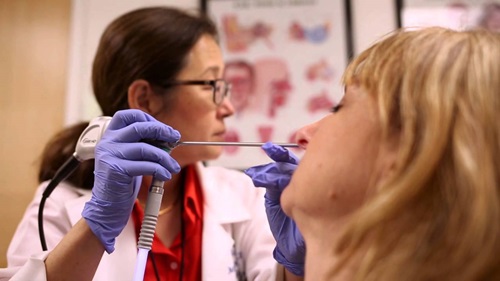Cerebrospinal Fluid (CSF) Leak
What You Need to Know
- Cerebrospinal fluid (CSF) is a watery liquid that continually circulates through the brain’s ventricles (hollow cavities) and around the surface of the brain and spinal cord.
- CSF washes out impurities from the brain, transfers nutrients and provides protective cushioning to the brain and spinal cord.
- The fluid is contained by the meninges, a series of protective membranes that surround the brain and spinal cord.
- CSF leaks can cause fluid to leak through the ears, through the nose or into the spinal canal.
- CSF leakage through the ears or nose should be diagnosed and treated quickly and effectively to prevent meningitis, an infection of the meninges.
What is cerebrospinal fluid?
Cerebrospinal fluid (CSF) is a clear liquid that surrounds the brain and spinal cord. It provides a cushion for delicate brain and spinal tissue. Reduced cerebrospinal fluid, as in the case of a leak, requires immediate care by a trained expert.
What is a CSF leak?
A CSF leak is when the CSF escapes through a tear or hole in the dura, the outermost layer of the meninges, which surround the brain. The dura can be injured or punctured during a head injury or a surgical procedure involving the sinuses, brain or spine. It may also be damaged by a lumbar puncture, including a spinal tap, spinal anesthesia or myelogram. Spontaneous CSF leaks can occur due to increased intracranial pressure (pressure in the head). This can happen to patients with hydrocephalus, a buildup of CSF in the skull. Spontaneous leaks may also occur without an identifiable cause.
CSF Leak Symptoms
Symptoms of a CSF leak include:
- Headache
- Meningitis (bacterial or viral)
- Nasal drainage of CSF (this may be difficult to distinguish from normal nasal discharge without testing)
- Tinnitus (ringing in the ears)
- Visual disturbances
Diagnosis of a CSF Leak
If your doctor suspects a CSF leak, he or she may recommend the following tests.
- Analysis of the nasal fluid: This test is used to detect beta-2 transferrin, a protein found almost exclusively in CSF.
- CT scan: This noninvasive diagnostic imaging procedure uses X-rays and computer technology to produce detailed imaging of bones and planes of the brain.
- MRI scan: This uses a large magnet, radiofrequencies and a computer to produce detailed images of organs and structures in the body. MRI scans can help determine the location and severity of a CSF leak. scan: This uses a large magnet, radiofrequencies and a computer to produce detailed images of organs and structures in the body. MRI scans can help determine the location and severity of a CSF leak.
- Cisternogram — CT or nuclear medicine: These two tests, each performed in a similar way, require a spinal tap (also known as a lumbar puncture) to administer a fluid to the CSF that allows your doctor to identify if a CSF leak is present and the source of the leak.
- A CT cisternogram may help identify the site of a CSF leak into the nasal cavities or mastoid bone. During this test, a contrast medium is injected into the spinal fluid through a spinal tap, and then a CT scan is performed.
- A pledget study can confirm whether CSF is leaking into the nose or mastoid from a break in the bone at the base of the skull. During this test, a radioactive tracer is injected into the spinal fluid through a spinal tap. Pledgets (small cotton pads) are inserted into the nose for several hours to collect fluid and are later checked for the presence of the radionuclide.
- During a myelogram scan, a contrasting substance is injected into the spinal cord, and MRI or CT scans are used to look for tears or ruptures in the dura.
CSF Leak Treatment
A CSF leak is a very serious condition, and patients who have tears in their dura with persistent CSF leaks need repair as soon as possible to reduce headache pain and the chance of meningitis.
Nasal CSF Leak
Surgery for endoscopic nasal CSF leak closure, which is performed entirely through the nostrils, does not require cutting through the skin. The CSF leak is repaired using your own tissue from the nose or with a biomaterial graft. Length of stay in the hospital depends on the size of the leak — most patients are in the hospital for a few days after surgery. Some patients may require a lumbar drain that is removed before going home.
Ear CSF Leak
Ear CSF leak closure requires cutting the skin behind the ear and removing portions of mastoid (honeycomb-like, bony tissue) to access the source of the CSF leak around the ear. Using your own tissue or a biomaterial graft, the surgeon repairs the leak and seals the surgical opening.
Spinal CSF Leak
For CSF leaks that drain into the spinal canal, there are other treatments, such as use of blood or fibrin patches. For these procedures, the physician uses CT guidance to inject a small amount of the patient’s own blood or a plug of fibrin (the fibrous protein in blood that helps it clot) into the spinal canal. This can often repair the leak. If these methods fail, duraplasty — surgical repair of the dura — may be necessary.
Sinus Center

The Johns Hopkins Sinus Center provides state-of-the-art evaluation and treatment for a variety of nose and sinus conditions, including environmental allergies, nasal obstruction, nasal tumor and related disorders.




